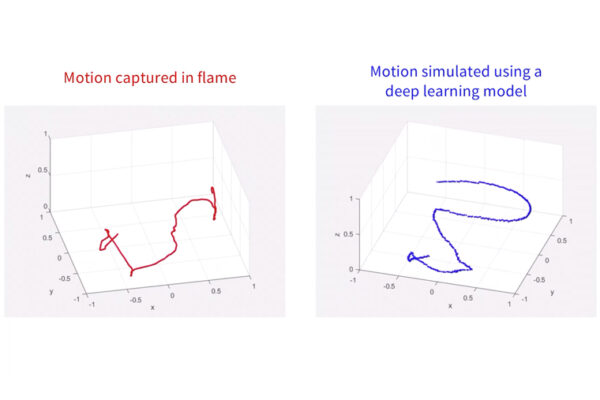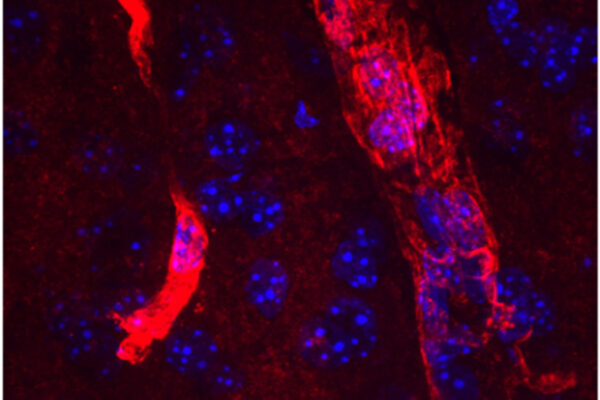Scientists at Washington University in St. Louis have developed a breath test that quickly identifies those who are infected with the virus that causes COVID-19. The device requires only one or two breaths and provides results in less than a minute.
The study is available online in the journal ACS Sensors. The same group of researchers recently published a paper in the journal Nature Communications about an air monitor they had built to detect airborne SARS-CoV-2 — the virus that causes COVID-19 — within about five minutes in hospitals, schools and other public places.
The new study is about a breath test that could become a tool for use in doctors’ offices to quickly diagnose people infected with the virus. If and when new strains of COVID-19 or other airborne pathogenic diseases arise, such devices also could be used to screen people at public events. The researchers said the breath test also has potential to help prevent outbreaks in situations where many people live or interact in close quarters — for example aboard ships, in nursing homes, in residence halls at colleges and universities or on military bases.
“With this test, there are no nasal swabs and no waiting 15 minutes for results, as with home tests,” said co-corresponding author Rajan K. Chakrabarty, the Harold D. Jolley Career Development Associate Professor of Energy, Environment & Chemical Engineering at the McKelvey School of Engineering. “A person simply blows into a tube in the device, and an electrochemical biosensor detects whether the virus is there. Results are available in about a minute.”
The biosensor used in the device was adapted from an Alzheimer’s disease-related technology developed by scientists at Washington University School of Medicine in St. Louis to detect amyloid beta and other Alzheimer’s disease-related proteins in the brains of mice. The School of Medicine’s John R. Cirrito, a professor of neurology, and Carla M. Yuede, an associate professor of psychiatry — both also co-corresponding authors on the study — used a nanobody, an antibody from llamas, to detect the virus that causes COVID-19.
Chakrabarty and Cirrito said the breath test could be modified to simultaneously detect other viruses, including influenza and respiratory syncytial virus (RSV). They also believe they can develop a biodetector for any newly emerging pathogen within two weeks of receiving samples of it.
“It’s a bit like a breathalyzer test that an impaired driver might be given,” Cirrito said. “And, for example, if people are in line to enter a hospital, a sports arena or the White House Situation Room, 15-minute nasal swab tests aren’t practical, and PCR tests take even longer. Plus, home tests are about 60% to 70% accurate, and they produce a lot of false negatives. This device will have diagnostic accuracy.”
The researchers began working on the breath test device — made with 3D printers — after receiving a grant from the National Institutes of Health (NIH) in August 2020, during the first year of the pandemic. Since receiving the grant, they’ve tested prototypes in the laboratory and in the Washington University Infectious Diseases Clinical Research Unit. The team continues to test the device, to further improve its efficacy at detecting the virus in people.
For the study, the research team tested COVID-positive individuals, each of whom exhaled into the device two, four or eight times. The breath test produced no false negatives and gave accurate reads after two breaths from each person tested. The clinical study is ongoing to test COVID-positive and -negative individuals to further test and optimize the device.
The researchers also found that the breath test successfully detected several different strains of SARS-CoV-2, including the original strain and the omicron variant, and their clinical studies are measuring active strains in the St. Louis area.
To conduct the breath test, the researchers insert a straw into the device. A patient blows into the straw, and then aerosols from the person’s breath collect on a biosensor inside the device. The device then is plugged into a small machine that reads signals from the biosensor, and in less than a minute, the machine reveals a positive or negative finding of COVID-19.
Clinical studies are continuing, and the researchers soon plan to employ the device in clinics beyond Washington University’s Infectious Diseases Clinical Research Unit. In addition, Y2X Life Sciences, a New York-based company, has an exclusive option to license the technology. That company has consulted with the research team from the beginning of the project and during the device’s design stages to facilitate possible commercialization of the test in the future.
Ghumra DP, Nishit, S, McBrearty KR, Puthussery JV, Sumlin BJ, Gardiner W, Doherty BM, Magrecki JP, Brody DL, Esparza TJ, O’Halloran J, Presti R, Bricker TL, Boon ACM, Yuede CM, Cirrito, JR, Chakrabarty RK. Rapid direct detection of SARS-CoV-2 aerosols in exhaled breath at the point-of-care. ACS Sensors, July 27, 2023. https://doi.org/10.1021/acssensors.3c00512
The study was funded by the National Institutes of Health (NIH) RADx-Rad program. Grant numbers U01 AA029331 and U01 AA029331-S1. Additional funding from the National Institute of Neurological Disorders and Stroke Intramural Research Program, the Uniformed Services University of Health Sciences and the NIH SARS-CoV-2 Assessment of Viral Evolution (SAVE) Program.
About Washington University School of Medicine
WashU Medicine is a global leader in academic medicine, including biomedical research, patient care and educational programs with 2,800 faculty. Its National Institutes of Health (NIH) research funding portfolio is the third largest among U.S. medical schools, has grown 52% in the last six years, and, together with institutional investment, WashU Medicine commits well over $1 billion annually to basic and clinical research innovation and training. Its faculty practice is consistently within the top five in the country, with more than 1,800 faculty physicians practicing at 65 locations and who are also the medical staffs of Barnes-Jewish and St. Louis Children’s hospitals of BJC HealthCare. WashU Medicine has a storied history in MD/PhD training, recently dedicated $100 million to scholarships and curriculum renewal for its medical students, and is home to top-notch training programs in every medical subspecialty as well as physical therapy, occupational therapy, and audiology and communications sciences.
The McKelvey School of Engineering at Washington University in St. Louis promotes independent inquiry and education with an emphasis on scientific excellence, innovation and collaboration without boundaries. McKelvey Engineering has top-ranked research and graduate programs across departments, particularly in biomedical engineering, environmental engineering and computing, and has one of the most selective undergraduate programs in the country. With 165 full-time faculty, 1,420 undergraduate students, 1,614 graduate students and 21,000 living alumni, we are working to solve some of society’s greatest challenges; to prepare students to become leaders and innovate throughout their careers; and to be a catalyst of economic development for the St. Louis region and beyond.



